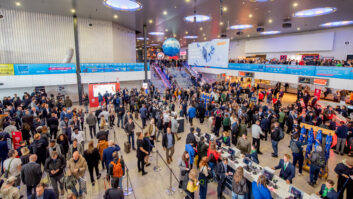
In the past year or so, some remarkable changes have become apparent in the market for AV technology for primary and secondary schools, as Ian McMurray discovers.
There was a time, in British schools, when, if a teacher wanted to get your attention, he would aim a piece of chalk – or even a blackboard duster – at your head. Since such practices were judged – probably rightly – to be somewhat barbaric, teaching has sought other ways of engaging pupils.
Originally invented by Xerox in 1990 (although the distinction of being first is claimed by SMART Technologies, which probably did more than any company to popularise them), interactive whiteboards (IWBs) were commonplace in schools by the early 2000s. The education technology phenomenon can perhaps be said to have begun at that point.
And, for many years, the IWB reigned supreme. Over the past year or two, however, something of a revolution has taken place.
A thing of the past
“Interactive whiteboards are now becoming a thing of the past,” according to Toni Barnett, managing director of integrator CDEC. “Moving with the times, we have much better technology now that enables teachers to connect their tablet or mobile device wirelessly to screens via integrated software. This eradicates the need for a physical connection and means teachers can move around the classroom and engage with their pupils rather than being constrained to their desk.”
“That said,” she continues, “interactive whiteboards do still serve a purpose in some educational establishments and are still put to good use.”
“IWBs are not so popular these days,” echoes Jon Garaway, education sales, NEC Display Solutions. “They’re being ousted in favour of UST projection and screen technology which offer more flexibility for future-proofing.”
“Advancements such as ultra-short-throw models have completely revolutionised the teaching experience when using projection,” claims Phil Clark, head of projection at Casio UK. “These can typically generate an image of around 80in from a distance of just 27cm, meaning that never again will teachers have the light shining in their eyes!”
Certainly, education is one of the most important markets served by UST projectors.
“Schools are targeted with equipment and software which directly address their needs,” Garaway continues. “UST projection was developed specifically for the education market to recognise the needs of small classrooms accommodating a larger number of children.”
“Yes, IWBs are still used today,” says Lucy Meredith, product marketing specialist at Panasonic Visual System Solutions. “However, dominating the market now are interactive screens, which make it easier than ever to bring interactivity and content sharing to teaching. Interactive screens provide learning content on high-quality, HD displays that require minimal set-up time and very low power consumption. Interactive displays allow the teacher to use the latest state-of-the-art technology.”
The new economics
That change is partially being driven by the new economics. “As the price point between interactive whiteboards and interactive flatpanels has narrowed, schools have quickly switched to the newer technology both for the benefits of functionality and image as well as the aesthetic qualities,” believes Helene Podmore, head of education solutions at distributor Steljes. “The removal of the requirement to hold or quickly purchase replacement projector bulbs at high cost, as well as some of the other cost-saving benefits of this newer technology, also make it a popular choice.”
Meredith too sees a desire to move towards technologies with lower cost of ownership.
And that, it seems, is something of a sea change in educational AV technology. There is a recurring theme in the industry that, driven by the growing pervasiveness of technology in everyone’s lives, and our familiarity and comfort with it, the rules are changing.
“Increasingly, what schools want most of all is the latest thing,” notes Adrian Robertson, managing director, Scotland for integrator AVMI. “The last six months has seen a big swing towards screens. There is a real appetite for flatpanels that’s really surprised us. Budgets are tight within education departments – yet despite this, clients repeatedly, when offered low-cost IWB solutions, opt for more expensive interactive screen technologies.
“Once upon a time, it was all about software,” he continues. “Now, it’s all about hardware. Growing numbers of schools are investing in very large flatpanel displays that are, in effect, dumb – they’re being used in a traditional IWB role but, interestingly, also as collaboration tools interacting with students’ own devices.”
He notes, however, that growing numbers of these screens are starting to feature Android, making them more capable.
The shift away from software specifically designed for education is easy to trace.
“The increased number of online resources, free apps and functionality within cloud- and web-based tools all benefit teaching and learning,” notes Podmore, “whether they were specifically designed for education or found to be useful for that market sector.”
Click for the second part – the rise of classroom interactivity and collaboration
AVMI
Casio projectors
CDEC
NEC Display Solutions
Panasonic Visual System Solutions
Steljes education solutions distribution







